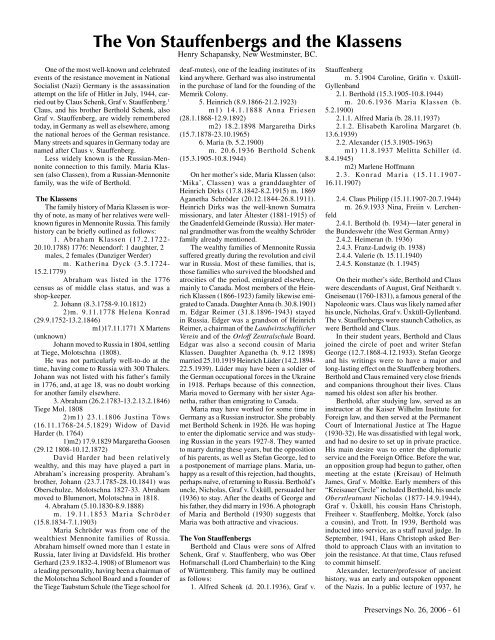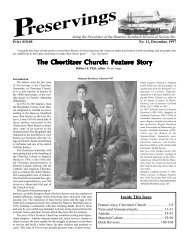Preservings $20 Issue No. 26, 2006 - Home at Plett Foundation
Preservings $20 Issue No. 26, 2006 - Home at Plett Foundation
Preservings $20 Issue No. 26, 2006 - Home at Plett Foundation
You also want an ePaper? Increase the reach of your titles
YUMPU automatically turns print PDFs into web optimized ePapers that Google loves.
The Von Stauffenbergs and the Klassens<br />
Henry Schapansky, New Westminster, BC.<br />
One of the most well-known and celebr<strong>at</strong>ed<br />
events of the resistance movement in N<strong>at</strong>ional<br />
Socialist (Nazi) Germany is the assassin<strong>at</strong>ion<br />
<strong>at</strong>tempt on the life of Hitler in July, 1944, carried<br />
out by Claus Schenk, Graf v. Stauffenberg. 1<br />
Claus, and his brother Berthold Schenk, also<br />
Graf v. Stauffenberg, are widely remembered<br />
today, in Germany as well as elsewhere, among<br />
the n<strong>at</strong>ional heroes of the German resistance.<br />
Many streets and squares in Germany today are<br />
named after Claus v. Stauffenberg.<br />
Less widely known is the Russian-Mennonite<br />
connection to this family. Maria Klassen<br />
(also Classen), from a Russian-Mennonite<br />
family, was the wife of Berthold.<br />
The Klassens<br />
The family history of Maria Klassen is worthy<br />
of note, as many of her rel<strong>at</strong>ives were wellknown<br />
figures in Mennonite Russia. This family<br />
history can be briefly outlined as follows:<br />
1. Abraham Klassen (17.2.1722-<br />
20.10.1788) 1776: Neuendorf: 1 daughter, 2<br />
males, 2 females (Danziger Werder)<br />
m. K<strong>at</strong>herina Dyck (3.5.1724-<br />
15.2.1779)<br />
Abraham was listed in the 1776<br />
census as of middle class st<strong>at</strong>us, and was a<br />
shop-keeper.<br />
2. Johann (8.3.1758-9.10.1812)<br />
2)m. 9.11.1778 Helena Konrad<br />
(29.9.1752-13.2.1846)<br />
m1)17.11.1771 X Martens<br />
(unknown)<br />
Johann moved to Russia in 1804, settling<br />
<strong>at</strong> Tiege, Molotschna (1808).<br />
He was not particularly well-to-do <strong>at</strong> the<br />
time, having come to Russia with 300 Thalers.<br />
Johann was not listed with his f<strong>at</strong>her’s family<br />
in 1776, and, <strong>at</strong> age 18, was no doubt working<br />
for another family elsewhere.<br />
3. Abraham (<strong>26</strong>.2.1783-13.2.13.2.1846)<br />
Tiege Mol. 1808<br />
2)m1) 23.1.1806 Justina Töws<br />
(16.11.1768-24.5.1829) Widow of David<br />
Harder (b. 1764)<br />
1)m2) 17.9.1829 Margaretha Goosen<br />
(29.12 1808-10.12.1872)<br />
David Harder had been rel<strong>at</strong>ively<br />
wealthy, and this may have played a part in<br />
Abraham’s increasing prosperity. Abraham’s<br />
brother, Johann (23.7.1785-28.10.1841) was<br />
Oberschulze, Molotschna 1827-33. Abraham<br />
moved to Blumenort, Molotschna in 1818.<br />
4. Abraham (5.10.1830-8.9.1888)<br />
m. 19.11.1853 Maria Schröder<br />
(15.8.1834-7.1.1903)<br />
Maria Schröder was from one of the<br />
wealthiest Mennonite families of Russia.<br />
Abraham himself owned more than 1 est<strong>at</strong>e in<br />
Russia, l<strong>at</strong>er living <strong>at</strong> Davidsfeld. His brother<br />
Gerhard (23.9.1832-4.1908) of Blumenort was<br />
a leading personality, having been a chairman of<br />
the Molotschna School Board and a founder of<br />
the Tiege Taubstum Schule (the Tiege school for<br />
deaf-mutes), one of the leading institutes of its<br />
kind anywhere. Gerhard was also instrumental<br />
in the purchase of land for the founding of the<br />
Memrik Colony.<br />
5. Heinrich (8.9.1866-21.2.1923)<br />
m1) 14.1.1888 Anna Friesen<br />
(28.1.1868-12.9.1892)<br />
m2) 18.2.1898 Margaretha Dirks<br />
(15.7.1878-23.10.1965)<br />
6. Maria (b. 5.2.1900)<br />
m. 20.6.1936 Berthold Schenk<br />
(15.3.1905-10.8.1944)<br />
On her mother’s side, Maria Klassen (also:<br />
‘Mika’, Classen) was a granddaughter of<br />
Heinrich Dirks (17.8.1842-8.2.1915) m. 1869<br />
Aganetha Schröder (20.12.1844-<strong>26</strong>.8.1911).<br />
Heinrich Dirks was the well-known Sum<strong>at</strong>ra<br />
missionary, and l<strong>at</strong>er Ältester (1881-1915) of<br />
the Gnadenfeld Gemeinde (Russia). Her m<strong>at</strong>ernal<br />
grandmother was from the wealthy Schröder<br />
family already mentioned.<br />
The wealthy families of Mennonite Russia<br />
suffered gre<strong>at</strong>ly during the revolution and civil<br />
war in Russia. Most of these families, th<strong>at</strong> is,<br />
those families who survived the bloodshed and<br />
<strong>at</strong>rocities of the period, emigr<strong>at</strong>ed elsewhere,<br />
mainly to Canada. Most members of the Heinrich<br />
Klassen (1866-1923) family likewise emigr<strong>at</strong>ed<br />
to Canada. Daughter Anna (b. 30.8.1901)<br />
m. Edgar Reimer (31.8.1896-1943) stayed<br />
in Russia. Edger was a grandson of Heinrich<br />
Reimer, a chairman of the Landwirtschaftlicher<br />
Verein and of the Orloff Zentralschule Board.<br />
Edgar was also a second cousin of Maria<br />
Klassen. Daughter Aganetha (b. 9.12 1898)<br />
married 25.10.1919 Heinrich Lüder (14.2.1894-<br />
22.5.1939). Lüder may have been a soldier of<br />
the German occup<strong>at</strong>ional forces in the Ukraine<br />
in 1918. Perhaps because of this connection,<br />
Maria moved to Germany with her sister Aganetha,<br />
r<strong>at</strong>her than emigr<strong>at</strong>ing to Canada.<br />
Maria may have worked for some time in<br />
Germany as a Russian instructor. She probably<br />
met Berthold Schenk in 19<strong>26</strong>. He was hoping<br />
to enter the diplom<strong>at</strong>ic service and was studying<br />
Russian in the years 1927-8. They wanted<br />
to marry during these years, but the opposition<br />
of his parents, as well as Stefan George, led to<br />
a postponement of marriage plans. Maria, unhappy<br />
as a result of this rejection, had thoughts,<br />
perhaps naïve, of returning to Russia. Berthold’s<br />
uncle, Nicholas, Graf v. Üxküll, persuaded her<br />
(1936) to stay. After the de<strong>at</strong>hs of George and<br />
his f<strong>at</strong>her, they did marry in 1936. A photograph<br />
of Maria and Berthold (1930) suggests th<strong>at</strong><br />
Maria was both <strong>at</strong>tractive and vivacious.<br />
The Von Stauffenbergs<br />
Berthold and Claus were sons of Alfred<br />
Schenk, Graf v. Stauffenberg, who was Ober<br />
Hofmarschall (Lord Chamberlain) to the King<br />
of Württemberg. This family may be outlined<br />
as follows:<br />
1. Alfred Schenk (d. 20.1.1936), Graf v.<br />
Stauffenberg<br />
m. 5.1904 Caroline, Gräfin v. Üxküll-<br />
Gyllenband<br />
2.1. Berthold (15.3.1905-10.8.1944)<br />
m. 20.6.1936 Maria Klassen (b.<br />
5.2.1900)<br />
2.1.1. Alfred Maria (b. 28.11.1937)<br />
2.1.2. Elisabeth Karolina Margaret (b.<br />
13.6.1939)<br />
2.2. Alexander (15.3.1905-1963)<br />
m1) 11.8.1937 Melitta Schiller (d.<br />
8.4.1945)<br />
m2) Marlene Hoffmann<br />
2 . 3 . Ko n r a d M a r i a ( 1 5 . 1 1 . 1 9 0 7 -<br />
16.11.1907)<br />
2.4. Claus Philipp (15.11.1907-20.7.1944)<br />
m. <strong>26</strong>.9.1933 Nina, Freiin v. Lerchenfeld<br />
2.4.1. Berthold (b. 1934)—l<strong>at</strong>er general in<br />
the Bundeswehr (the West German Army)<br />
2.4.2. Heimeran (b. 1936)<br />
2.4.3. Franz-Ludwig (b. 1938)<br />
2.4.4. Valerie (b. 15.11.1940)<br />
2.4.5. Konstanze (b. 1.1945)<br />
On their mother’s side, Berthold and Claus<br />
were descendants of August, Graf Neithardt v.<br />
Gneisenau (1760-1831), a famous general of the<br />
Napoleonic wars. Claus was likely named after<br />
his uncle, Nicholas, Graf v. Üxküll-Gyllenband.<br />
The v. Stauffenbergs were staunch C<strong>at</strong>holics, as<br />
were Berthold and Claus.<br />
In their student years, Berthold and Claus<br />
joined the circle of poet and writer Stefan<br />
George (12.7.1868-4.12.1933). Stefan George<br />
and his writings were to have a major and<br />
long-lasting effect on the Stauffenberg brothers.<br />
Berthold and Claus remained very close friends<br />
and companions throughout their lives. Claus<br />
named his oldest son after his brother.<br />
Berthold, after studying law, served as an<br />
instructor <strong>at</strong> the Kaiser Wilhelm Institute for<br />
Foreign law, and then served <strong>at</strong> the Permanent<br />
Court of Intern<strong>at</strong>ional Justice <strong>at</strong> The Hague<br />
(1930-32). He was diss<strong>at</strong>isfied with legal work,<br />
and had no desire to set up in priv<strong>at</strong>e practice.<br />
His main desire was to enter the diplom<strong>at</strong>ic<br />
service and the Foreign Office. Before the war,<br />
an opposition group had begun to g<strong>at</strong>her, often<br />
meeting <strong>at</strong> the est<strong>at</strong>e (Kreisau) of Helmuth<br />
James, Graf v. Moltke. Early members of this<br />
“Kreisauer Circle” included Berthold, his uncle<br />
Oberstleutnant Nicholas (1877-14.9.1944),<br />
Graf v. Üxküll, his cousin Hans Christoph,<br />
Freiheer v. Stauffenberg, Moltke, Yorck (also<br />
a cousin), and Trott. In 1939, Berthold was<br />
inducted into service, as a staff naval judge. In<br />
September, 1941, Hans Christoph asked Berthold<br />
to approach Claus with an invit<strong>at</strong>ion to<br />
join the resistance. At th<strong>at</strong> time, Claus refused<br />
to commit himself.<br />
Alexander, lecturer/professor of ancient<br />
history, was an early and outspoken opponent<br />
of the Nazis. In a public lecture of 1937, he<br />
<strong>Preservings</strong> <strong>No</strong>. <strong>26</strong>, <strong>2006</strong> - 61
















